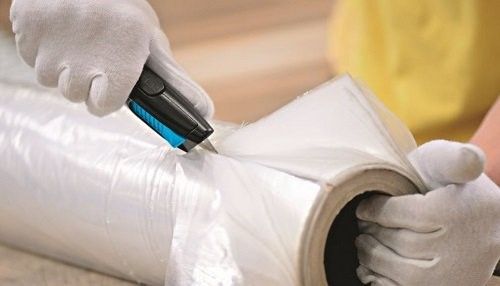
Implementing a safety knife program can be more difficult than it first appears. There are usually many different people using knives for various cutting applications. Couple that with the general distaste for safety knives and you have a complicated problem on your hands. Here's a quick guide with some tips to making the change to safety knives a successful one:
1. Identify the level of safety associated with your current cutting tools.
This graphic helps you determine if there is a level of safety ahead of the current tools you are using:
2. Identify the cutting applications.
Knowing what your employees are using utility knives to cut is important in determining which safety cutter will be best for them. Someone cutting shrink wrap all day will be using a very different knife than someone that mostly cuts triple wall boxes
3. Use training materials to teach people proper operation.
The main objections to safety knives are usually because the operator simply isn't using the knife correctly which is not a valid reason to avoid using it all together. Take slabbing for example. Operators have long incorrectly assumed that a safety knife can't be used to slab material off rolls. But this tutorial clearly shows how to use a slider style safety knife to do just that:
4. Have reasonable expectations for the performance of the new safety knife.
Regular utility knives are widely used for cutting many materials. It's important to note that there may be task specific tools to replace utility knives. Wire stripping is a great example. Most maintenance workers are able to strip wires with pocket knives or other dangerous fixed blade tools. They will say that safety knives make it more difficult to perform this task because the blade retracts too often. First, the blade retracting is what minimizes the risk of laceration. But second, wire strippers are the correct tool for the job.
5. Stay focused on your commitment to reduce the risk of laceration in your facility.
Operators will always come up with clever excuses in an attempt to avoid using a safety knife but it's important for you to stay focused on your goal of making the workplace safer. As mentioned above, these objections are usually overcome by training the individual on proper operation. However, there may be an occasional situation in which a different tool may be needed for a task. If this is the case, avoid letting the operator over complicate the issue and look into the possibility that a different safety knife may work better in a certain scenario.
Let's assume the first safety knife you chose works in 90% of the applications but the operators are struggling with the other 10%. First, this is not a valid excuse to stop using the safety knife for the 90% in which it works. Second, having an alternative safety knife available for those rare 10% circumstances is not asking too much of your employees. After all, they usually carry and/or use many other tools throughout the day so one more is reasonable.
6. Don't be afraid to ask for help.
Safety knives are no different than other manufactured products these days. They vary widely in quality, price, availability and performance. The manufacturers themselves also vary tremendously in the quality of customer service provided. We at Martor USA pride ourselves in providing reasonably priced quality products with excellent customer service. We don't carry anything else but safety knives so that makes us a master of the trade. Please don't hesitate to contact us if we can help with anything at all - [email protected] or (920) 662-9646.

Please login to comment.
Don't have an account?
Sign Up for free